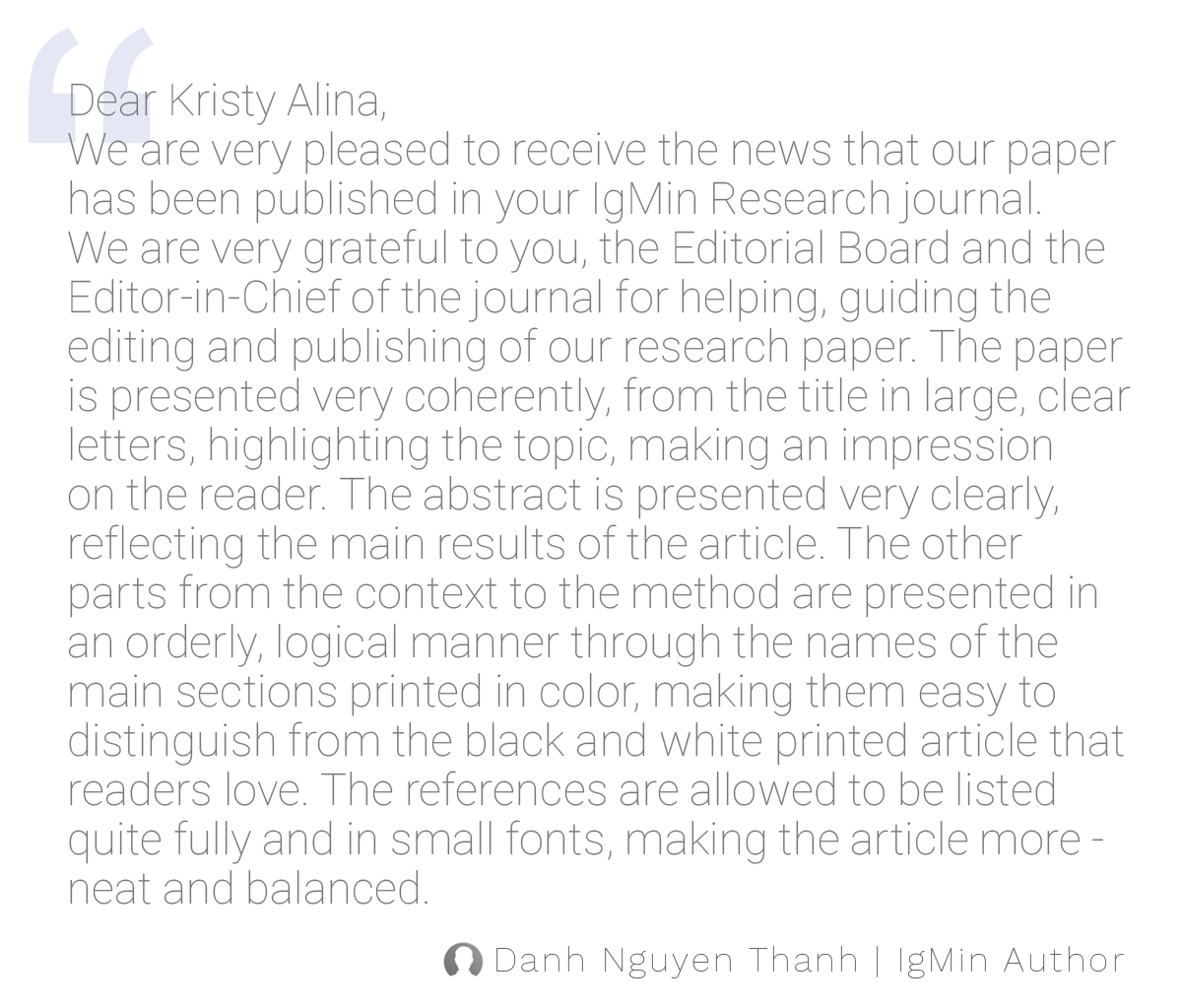- Introduction:
- The document outlines the authorship criteria for IgMin Research - A BioMed & Engineering Open Access Journal, a Gold Open-Access journal.
- These criteria are aligned with globally accepted standards as of 2023, aiming to ensure transparency, fairness, and proper acknowledgment of contributors.
- Adherence to these guidelines is crucial for maintaining the journal's integrity and credibility.
- Substantial Contribution:
- Authors must significantly contribute to the conception, design, execution, or interpretation of the research.
- They should actively participate in manuscript development and critically review and approve the final version.
- Authorship Responsibility:
- Authors are accountable for the accuracy and integrity of the work.
- They must ensure ethical conduct of the research and disclose any conflicts of interest.
- Criteria for Authorship:
- Conception and Design: Significant contribution to study design and research questions.
- Data Collection and Analysis: Active participation in data collection, analysis, and interpretation.
- Drafting and Revising: Involvement in manuscript drafting and critical revision.
- Approval of the Final Version: Approval and responsibility for the final manuscript.
- Acknowledging Contributions:
- Non-author contributors should be acknowledged in the manuscript's acknowledgment section.
- Corresponding Author:
- The corresponding author handles manuscript submission, communication with the journal, and ensures all co-authors approve the final version.
- Authorship Disputes:
- Disputes are to be resolved following the guidelines of the Committee on Publication Ethics (COPE).
- The journal’s editorial board will make the final decision if disputes remain unresolved.
- Changes in Authorship:
- Changes in authorship after submission require approval from all authors and a detailed explanation.
- The journal reserves the right to evaluate these requests.
- Ethical Considerations:
- Compliance with ethical regulations, informed consent, confidentiality, and humane treatment of research subjects is mandatory.
- Disclosure of funding sources and financial interests is required.
- Data Availability:
- Authors should be ready to share raw data upon request to promote transparency and replicability of studies.
- Retraction and Correction:
- Authors must retract or correct their work if significant errors or ethical issues are identified post-publication.
- Ghost and Guest Authorship:
- Ghost and guest authorship are discouraged.
- Authors must be listed only if they have made significant contributions to the research or manuscript.
- Multiple Submissions and Redundant Publication:
- Simultaneous submissions to multiple journals and redundant publications are prohibited.
- Plagiarism:
- The journal employs plagiarism detection software.
- Plagiarism and self-plagiarism are considered serious ethical violations.
- Image Manipulation:
- Images should be free from manipulation that alters the scientific meaning.
- Any enhancements must be clearly stated.
- Post-Publication Discussions and Corrections:
- The journal encourages scholarly debate and is open to publishing rebuttals and corrections if significant errors are found.
- Sanctions:
- Proven misconduct, including plagiarism and ethical violations, will result in appropriate actions such as article retraction and reporting to institutions.
- Authorship Order:
- The order should reflect the level of contribution, with the most significant contributor as the first author and the senior author or principal investigator often listed last.
- Equal Contribution:
- Equal contributions by two or more authors should be indicated clearly in the manuscript.
- Authorship and Collaboration:
- Collaborative research should determine authorship and order collectively, especially in multi-center trials.
- Role of Funding Source:
- The role of funding sources in the research must be clearly stated, ensuring they do not influence the study design or publication decision.
- Authorship and Accountability:
- Authors must be prepared to defend their published work and cooperate in investigations of accuracy or validity.
- Authorship and Peer Review:
- Authors should engage responsibly in the peer review process, respecting its confidentiality.
- Authorship Confidentiality:
- Communication with the journal should be treated as confidential unless explicit consent for disclosure is received.
The outlined criteria aim to uphold high standards of integrity, accountability, and ethical conduct in scientific publishing. - Authors are encouraged to review and adhere to these guidelines to ensure their work is recognized and respected globally. - These criteria are subject to periodic review and updates to stay aligned with evolving standards. - Adherence to these guidelines fosters a scholarly environment valuing contributions and maintaining scientific integrity.
Why publish with us?
Global Visibility – Indexed in major databases
Fast Peer Review – Decision within 14–21 days
Open Access – Maximize readership and citation
Multidisciplinary Scope – Biology, Medicine and Engineering
Editorial Board Excellence – Global experts involved
University Library Indexing – Via OCLC
Permanent Archiving – CrossRef DOI
APC – Affordable APCs with discounts
Citation – High Citation Potential
Which articles are now trending?
Research Articles
- DNA Genetics and UHPLC-Q-TOF-MS Analysis of Phytochemicals for Asparagus racemosus Roots
- The Examination of Game Skills of Children Aged 5-6 Years Participating in Movement Education
- Analytical Expressions of the Markov Chain of K-Ras4B Protein within the Catalytic Environment and a New Markov-State Model
- The Influence of Low Pesticide Doses on Fusarium Molds
- Current Oscillations and Resonances in Nanocrystals of Narrow-gap Semiconductors
- Risk of Nutritional Deficiencies and Changes in Dietary Patterns after Bariatric Surgery
Advertisement







